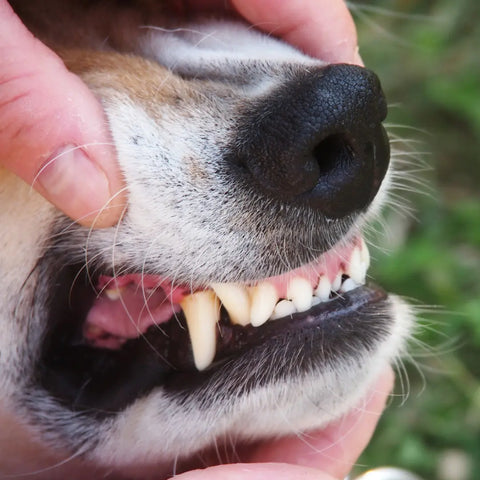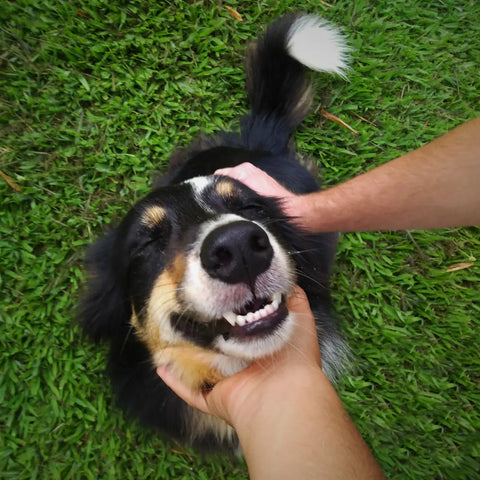Oral disease (also known as dog dental disease or periodontal disease) is a common and often overlooked issue in dogs that can lead to serious health problems if not properly addressed. Just like humans, dogs need regular oral care to maintain healthy teeth and gums. Dental health is crucial in canines. Oral infections are actually the most common dog disease and tend to become an issue in dogs after the age of three.
Dogs can suffer from periodontal disease, a progressive condition affecting oral health. In this blog post, we will explore the various types of oral disease in dogs, their causes, symptoms, and treatment options to help you better understand and prevent these issues in your furry friends.
Types of Oral Disease in Dogs
There are several common types of oral disease that can affect dogs, including:
- Gingivitis: Gingivitis (gum disease) is inflammation of the gums caused by a buildup of plaque and tartar on the teeth. If left untreated, gingivitis can progress to periodontal disease, a more serious condition that can lead to tooth loss and other health problems.
- Periodontal Disease: Periodontal disease is a progressive condition that affects the supporting structures of the teeth, including the gums, periodontal ligament, and alveolar bone. It is the most common oral disease in dogs and is caused by a combination of plaque, bacteria, and inflammation.
- Tooth Abscess: A tooth abscess is a painful infection that occurs when bacteria enter the pulp chamber of a tooth, usually as a result of advanced periodontal disease or a broken tooth. Left untreated, a tooth abscess can lead to severe pain, swelling, and even systemic infection.
- Oral Tumors: Oral tumors can develop in the mouth or throat of dogs and can be benign or malignant. Common types of oral tumors in dogs include squamous cell carcinoma, melanoma, and fibrosarcoma. Early detection and treatment are crucial for a positive outcome.
Note: Regular dog grooming is crucial for a pet's overall health, not just for their appearance. This includes dental care, often overlooked but vital for preventing painful diseases. Using the right dog shampoo is equally important, maintaining their coat's health and skin condition.
Causes of Oral Disease and Gum Disease in Dogs

There are several factors that can contribute to the development of oral disease in dogs, including:
- Poor Dental Hygiene: Just like humans, dogs need regular dental care to prevent the buildup of plaque and tartar on their teeth. Without proper brushing and professional cleanings, bacteria can accumulate and lead to gingivitis and periodontal disease.
- Genetics: Some dogs are more prone to developing oral disease due to genetic factors, such as breed predispositions or inherited dental issues. Breeds with short muzzle shapes, such as pugs and bulldogs, are more likely to experience dental problems.
- Age: Older dogs are more susceptible to oral disease due to years of plaque buildup and wear and tear on their teeth. As dogs age, their immune system may weaken, making them more vulnerable to infections and diseases.
- Diet: A poor diet high in carbohydrates and sugar can contribute to the formation of plaque and tartar on a dog's teeth. Feeding dogs table scraps or sugary treats can also increase their risk of developing oral disease.
Symptoms of Periodontal Disease in Dogs
It is important to pay attention to the following signs of oral disease in dogs:
- Bad Breath: Persistent bad breath, also known as halitosis, is a common symptom of oral disease in dogs and is often caused by bacteria in the mouth.
- Red or Inflamed Gums: Healthy gums should be pink and firm. Red, swollen, or bleeding gums may indicate gingivitis or periodontal disease.
- Tooth Pain: Dogs with oral disease may show signs of discomfort when eating, chewing, or playing with toys. They may also paw at their mouth or avoid certain foods.
- Loose or Missing Teeth: Advanced periodontal disease can lead to loose or missing teeth, which can affect a dog's ability to eat and cause pain and discomfort.
- Excessive Drooling: Dogs with oral disease may drool more than usual due to inflammation or infection in the mouth.
If you suspect or see any of the signs of dental disease noted above, make sure you visit your veterinarian for an evaluation as soon as possible. It’s essential to note that some dogs may not show obvious signs of dental disease until the condition has progressed significantly. Therefore, regular dental checkups by a veterinarian are essential to detect dental issues early on.
Note: Proper dog grooming is essential for a pet's health and happiness. Regular brushing using a suitable dog brush not only keeps their coat shiny but also promotes circulation and healthy skin. A good dog towel ensures they stay dry and comfortable, making grooming a pleasant experience for both dog and owner alike.
Treatment Options and Dental Health Tips for Oral Disease in Dogs
If you suspect that your dog has oral disease, it is important to consult with a veterinarian for a proper diagnosis and treatment plan. A dental procedure may be necessary. Treatment options for oral disease in dogs may include:
- Dental Cleaning and Dental Procedures: Professional dental cleanings performed under anesthesia are essential for removing plaque, tartar, and bacteria from a dog's teeth and gums. Regular cleanings can help prevent oral disease and tooth loss, and maintain oral health.
- Tooth Extraction: In some dental procedures, severely infected or damaged teeth may need to be extracted to prevent further complications and alleviate pain. Fractured teeth are very common as dogs age.
- Antibiotics: Antibiotics may be prescribed to treat bacterial infections associated with oral disease, such as gingivitis, periodontal disease, or tooth abscesses.
- Pain Management: Dogs with oral disease may require pain medication or anti-inflammatory drugs to manage discomfort and inflammation.
- Oral Surgery: In cases of advanced oral disease or oral tumors, surgery may be necessary to remove infected tissue or tumors and restore oral health.
Only the first stage of periodontal disease is reversible. While further stages cannot be reversed, they can be treated and managed with anesthetic dental cleanings. Many pet parents have reservations about anesthesia, but it’s in your pet’s best interest. Vets take every precaution possible to ensure pets are kept safe while under anesthesia. Non-anesthetic dental cleanings are not recommended.
While having a dental cleaning, pets can receive all the same care that humans do for our dental cleanings to improve dental health, including:
- Full mouth exam with dental charting and probing
- Full mouth dental X-rays
- Scaling of dental plaque
- Polishing
- Tooth removal, if needed
All these procedures are recommended to help treat and manage dental disease and gum disease in dogs. Because anesthesia is involved in this procedure, dental cleanings can be pricey, depending on the region and whether you go to a general vet or a dental specialist. Prices can range anywhere from about $500 to $5,000 for dental cleanings for dogs. The higher end of the estimate is if you elect to go to a dental specialist to have specialized procedures done—such as a root canal to save a tooth from being extracted.
Remember, you can even start brushing your puppy’s teeth as early as 8 weeks old to get them used to the process. However, even if you provide great oral hygiene to your pup, they will still need regular dental cleanings throughout life.
Preventing Oral Disease in Dogs

Preventing oral disease in dogs starts with good dental hygiene and regular veterinary care. Here are some tips to help maintain your dog's oral health:
- Brushing your dog's teeth regularly with a dog-specific toothbrush and toothpaste can help remove plaque and prevent tartar buildup. Aim to brush your dog's teeth at least a few times a week, if not daily.
- Providing your dog with dental chews or toys that are specifically designed to help clean teeth can also be beneficial. These products can help reduce plaque and tartar buildup and promote good oral health.
- Feeding your dog a balanced and healthy diet can also contribute to good oral health. Avoid feeding your dog too many sugary or sticky treats, as these can lead to dental issues.
- Lastly, be on the lookout for signs of dental problems in your dog, such as bad breath, bleeding gums, loose or missing teeth, or reluctance to eat. If you notice any of these signs, be sure to take your dog to the veterinarian for a dental exam.
Detecting dental disease in dogs early is important to prevent its progression and ensure your pet’s wellbeing. Less than one-half (44%) of Gen Z and Millennial pet parents say they could list the signs of periodontal disease in dogs to their veterinarian, which include discoloration, broken or loose teeth, super stinky breath, reduced appetite, and inflamed gums. It is important to address dental disease as soon as it starts.
By following these tips and working with your veterinarian to develop a comprehensive dental care plan, you can help prevent oral disease in your dog and keep their teeth and gums healthy for years to come. We hope this information will shed light on the importance of regular dental care for our four-legged companions.
WHO IS PRIDE+GROOM?
PRIDE+GROOM was born because a group of New York City dog lovers wanted the same level of grooming products for their dogs that they themselves enjoyed. They looked (hard) but nothing was up to snuff. Or sniff. Like so many, we love our families and take pride in our homes, and we consider our pets to be integral parts of those entities. That said, we could not find an effective way to coif them that was on par with the way we tended to our children, our homes, or ourselves. These beloved pets are allowed on the furniture and in our beds, and yet even when fresh from the groomer, we knew they did not smell or feel as good as they could.
With the development of our coat-specific shampoos, conditioner and deodorizing spray, we think we found just the way to say thanks for being the best and the sweetest MVP of the house. Skin and coat health is very important to us.
PRIDE+GROOM is the first dog grooming brand launched under a beauty platform, with formulas made in a clean beauty and scent lab. We know beauty is not only skin deep. We did a ton of research to create the entire line. Each product is formulated with its own unique blend of essential oils sourced from around the world.
IN DOG WE TRUST
Shop our entire line: www.prideandgroom.com


